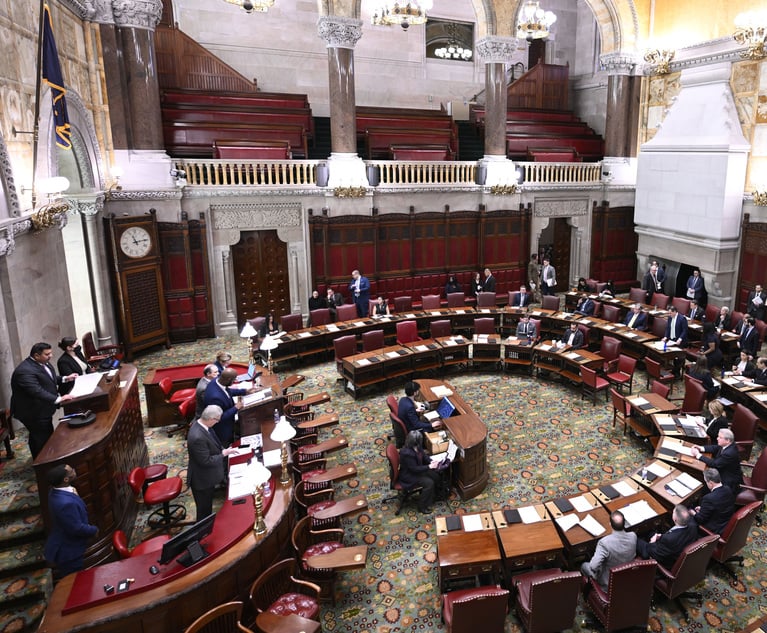The Intricacies of Therapeutic Foster Care
Similar to traditional foster care, therapeutic foster care (TFC) is temporary, its purpose being to prepare children for either reunification with their parents, independent living, or adoption. There is some evidence that TFC has helped certain foster children but further research is needed to discern whether the positive effects, if any, have been gained in a cost-effective manner and whether further program innovations are in order.
March 15, 2019 at 02:30 PM
10 minute read
 A women holding a child's hand/courtesy photo
A women holding a child's hand/courtesy photo
Therapeutic foster care (TFC), sometimes referred to as “treatment foster care” or “specialized foster care,” was developed as a means of serving high-need children and adolescents without removing them from a family environment. Similar to traditional foster care, TFC is temporary, its purpose being to prepare children for either reunification with their parents, independent living, or adoption. Although it is often available only for children who are juvenile dependents and/or delinquents, some states offer TFC to children who remain in their parents' care, but who need additional support due to a variety of complicated circumstances.
In short, TFC is out-of-home care provided by foster parents with specialized training. It is intended to serve children who would otherwise be placed in residential, institutional, or group homes due to significant behavioral, emotional, medical, or mental health care needs (McGuinness, T. M., & Dyer, J. G. (2007). Catchers in the rye: Treatment foster parents as a system of care. Journal of Child and Adolescent Psychiatric Nursing, 20(3), 140-47).
Types of TFC
There are essentially three different types of TFC programs: evidence-based models, evidence-informed models, and state TFC programs. Evidence-based models have been subjected to rigorous evaluations and have demonstrated improved outcomes in both the behavioral health of children and their delinquency experiences. Evidence-informed models are based on research and follow strict implementation standards, but have not been evaluated as rigorously as evidence-based models. State model often incorporate and adapt elements of evidence-based and evidence-informed models while allowing flexibility in the implementation of the individual programs to accommodate unique funding and resource limitations.
The two most widely recognized evidence-based TFC models are Treatment Foster Care Oregon and Together Facing the Challenge. Treatment Foster Care Oregon focuses on children with severe emotional and behavioral disorders and serves them with mentoring, high levels of structure and supervision, and a supportive environment. It has been shown to prevent or reduce the number of days a child stays in an institutional or residential setting, prevents the escalation of delinquency, reduces the number of placement disruptions, and improves brain stress regulatory systems. Together Facing the Challenge works with existing TFC providers to improve their outcomes with a low-cost approach to improving treatment.
Pressley Ridge TFC is an evidence-informed model that provides foster parents with advanced clinical and technical training and support. The program is trauma-focused and aims to provide permanency for youth. The Bair Foundation is an evidence-informed model that partners with Together Facing the Challenge in order to prepare its clients for placement, provide effective service planning, and develop competencies and resiliency.
As their names imply, state TFC models vary, sometimes even within counties. In North Dakota, one agency, PATH, provides TFC housing for all eligible children in the state. PATH serves children with severe emotional and behavioral problems. In order to do so, it recruits specialized, highly trained, and educated foster parents who are then certified in medication monitoring and crisis intervention.
Who Receives TFC?
Researchers in a 2016 study in the journal Pediatrics found that foster children were “about twice as likely to have a learning disability and three times as likely to have ADD or ADHD. They were also roughly twice as likely to have asthma and speech problems and three times as likely to have hearing problems and vision problems. Differences were even more substantial for other mental health conditions; they were five times as likely to have anxiety, six times as likely to have behavioral problems, and seven times as likely to have depression.”
In general, TFC is intended to meet the needs of children with significant emotional, behavioral, and social issues, as well as medically fragile children. According to a survey conducted in 2007, approximately 12.5 percent of children and adolescents receive treatment or counseling pertaining to behavioral and/or emotional problems. Of those children, just 0.4 percent were placed into a TFC home (Sharp, C., Williams, L. L., Ha, C., Baumgardner, J., Michonski, J., Seals, R., … & Fonagy, P. (2009). The development of a mentalization-based outcomes and research protocol for an adolescent inpatient unit. Bulletin of the Menninger Clinic, 73(4), 311-38).
The number of children receiving TFC services varies by state, ranging from approximately 250 children in North Dakota to approximately 3,000 children in New York. Similarly, each state has varying requirements for eligibility, though almost all states require that the children have significant mental health or medical needs. In Connecticut, children must meet the following criteria in order to be eligible for placement in a TFC foster home: (1) Have a mental disorder that creates substantial impairment in either self-care, school functioning, family relationships or the ability to function in the community; (2) Be at risk of removal from their home or have already been removed; (3) Have a mental disorder/impairment that has been present for at least six months and that is likely to continue for at least one year without treatment; (4) Display psychotic features which pose a risk of either suicide or violence towards others; and (5) Qualify for special education. By contrast, Tennessee will not allow children who pose a danger to themselves or others into its TFC program.
TFC eligibility is often determined by state or county child welfare agencies. The Child and Adolescent Needs and Strengths assessment tool is used in a number of states as a starting point in determining whether TFC would be a good fit for a particular child. From there, many states require that a child be assessed by a social worker and a licensed clinician before being placed into a TFC home, and individual counties within a state may have more or less stringent evaluation requirements.
For example, in New York City, children are assessed by a Placement Presentation Family Team, which may include staff from the Administration for Children's Services department, social workers, attorneys, and the child's biological family members. In Erie County, the Children's Services division of the Department of Social Services sends a referral form to all agencies that provide TFC services throughout the county. A county psychologist then meets with the child to determine whether a higher level of care is warranted.
Who Provides TFC?
TFC foster parents are required to be highly-skilled caregivers who act as partners in implementing a child's treatment plan. They are typically unrelated to the child. However, some states have made an effort to recruit specific children's family members. Almost all states require TFC parents to participate in additional training above and beyond that required of traditional foster parents. Nonetheless, there is “tremendous variation” regarding the training that TFC parents receive (Dorsey, S., Farmer, E. M., Barth, R. P., Greene, K. M., Reid, J., & Landsverk, J. (2008). Current status and evidence base of training for foster and treatment foster parents. Children and Youth Services Review, 30(12), 1403-1416). This may be, in part, due to the disparate oversight of TFC homes, both nationally and on the state-wide level.
TFCs may be licensed by private foster care placement organizations that are hired by the state to find placements for children in the state's custody. As of 2010, there were more than 3,500 such agencies providing TFC homes for youth in the United States (Murray, M. M., Southerland, D., Farmer, E. M., & Ballentine, K. (2010). Enhancing and adapting treatment foster care: Lessons learned in trying to change practice. Journal of Child and Family Studies, 19(4), 393-403).
Although states tend to monitor the agencies that license TFC homes, the private agencies are typically in charge of monitoring the TFC parents and homes and ensuring that they are complying with state and agency standards. Other states engage mental health professionals to monitor TFC homes. In California, the services used by an agency to provide direction to TFC parents are monitored by either a Licensed Practitioner of the Healing Arts or a Licensed Mental Health Professional, who then assumes “ultimate responsibility for the TFC services provided by the TFC parent.”
Placing Children in TFC Homes
The vast majority of states indicate that they are having difficulty placing more high-needs children in TFC because they simply do not have enough TFC homes available. There seem to be two main factors contributing to this deficit:
It can be difficult to entice foster parents to go through the additional training and other requirements necessary to qualify as TFC parents. Although TFC foster parents are compensated at higher rates than traditional parents, many current TFC parents said that they were not motivated to participate in TFC by the financial incentive yet were invested in helping to change children's lives. While this altruism is encouraging in that it increases the likelihood of a child's success in a TFC placement, it is difficult to determine how to create altruism in people who are not already providing TFC homes.
Moreover, states need a significantly higher number of TFC homes than traditional foster homes in order to serve the same number of children due to restrictions on how many children can be placed in TFC homes. Many states allow up to six foster children to be placed in one home, while TFC homes are generally permitted to have only one or two TFC children at one time.
Children who require TFC care have been through extremely traumatic experiences and have behaviors that are difficult to deal with. Many states report extreme difficulty in finding TFC parents who were willing to take children with a history of inappropriate sexual behaviors, violent or aggressive tendencies, or histories of delinquency. Older children and Spanish-speaking children are also more difficult to place. When placements cannot be found for these children, whether due to the unique circumstances of the child requiring TFC placement or due to a lack of available homes, the youth are, by default, placed in group homes, juvenile detention facilities, or residential facilities instead.
Unanswered Legal Questions
In many states, there are a number of unanswered legal questions regarding TFC:
• Is there a sufficient (or any) administrative and appeal process to dispute whether a child should be at a particular TFC “level”?
• If a child is in need of TFC but none is available what are the state's legal obligations?
• Are there program quality performance indicators that must be legally attained?
• Should there be a single federal definition of TFC?
• Is there sufficient clarity in the entrance and exit guidelines into and out of TFC?
There is some evidence that TFC has helped certain foster children. Further research is needed to discern whether the positive effects, if any, have been gained in a cost-effective manner and whether further program innovations are in order.
Carly Sanchez is a personal injury attorney at the Law Offices of Booth & Koskoff who specializes in representing in civil lawsuits dependent children who have been physically or sexually abused. Daniel Pollack is a professor at Yeshiva University's School of Social Work in New York City and a frequent expert witness in child welfare cases.
This content has been archived. It is available through our partners, LexisNexis® and Bloomberg Law.
To view this content, please continue to their sites.
Not a Lexis Subscriber?
Subscribe Now
Not a Bloomberg Law Subscriber?
Subscribe Now
NOT FOR REPRINT
© 2025 ALM Global, LLC, All Rights Reserved. Request academic re-use from www.copyright.com. All other uses, submit a request to [email protected]. For more information visit Asset & Logo Licensing.
You Might Like
View All

Federal Judge Pauses Trump Funding Freeze as Democratic AGs Plan Suit
4 minute read
Relaxing Penalties on Discovery Noncompliance Allows Criminal Cases to Get Decided on Merit
5 minute read
Bipartisan Lawmakers to Hochul Urge Greater Student Loan Forgiveness for Public-Interest Lawyers
Trending Stories
- 1States Accuse Trump of Thwarting Court's Funding Restoration Order
- 2Microsoft Becomes Latest Tech Company to Face Claims of Stealing Marketing Commissions From Influencers
- 3Coral Gables Attorney Busted for Stalking Lawyer
- 4Trump's DOJ Delays Releasing Jan. 6 FBI Agents List Under Consent Order
- 5Securities Report Says That 2024 Settlements Passed a Total of $5.2B
Who Got The Work
J. Brugh Lower of Gibbons has entered an appearance for industrial equipment supplier Devco Corporation in a pending trademark infringement lawsuit. The suit, accusing the defendant of selling knock-off Graco products, was filed Dec. 18 in New Jersey District Court by Rivkin Radler on behalf of Graco Inc. and Graco Minnesota. The case, assigned to U.S. District Judge Zahid N. Quraishi, is 3:24-cv-11294, Graco Inc. et al v. Devco Corporation.
Who Got The Work
Rebecca Maller-Stein and Kent A. Yalowitz of Arnold & Porter Kaye Scholer have entered their appearances for Hanaco Venture Capital and its executives, Lior Prosor and David Frankel, in a pending securities lawsuit. The action, filed on Dec. 24 in New York Southern District Court by Zell, Aron & Co. on behalf of Goldeneye Advisors, accuses the defendants of negligently and fraudulently managing the plaintiff's $1 million investment. The case, assigned to U.S. District Judge Vernon S. Broderick, is 1:24-cv-09918, Goldeneye Advisors, LLC v. Hanaco Venture Capital, Ltd. et al.
Who Got The Work
Attorneys from A&O Shearman has stepped in as defense counsel for Toronto-Dominion Bank and other defendants in a pending securities class action. The suit, filed Dec. 11 in New York Southern District Court by Bleichmar Fonti & Auld, accuses the defendants of concealing the bank's 'pervasive' deficiencies in regards to its compliance with the Bank Secrecy Act and the quality of its anti-money laundering controls. The case, assigned to U.S. District Judge Arun Subramanian, is 1:24-cv-09445, Gonzalez v. The Toronto-Dominion Bank et al.
Who Got The Work
Crown Castle International, a Pennsylvania company providing shared communications infrastructure, has turned to Luke D. Wolf of Gordon Rees Scully Mansukhani to fend off a pending breach-of-contract lawsuit. The court action, filed Nov. 25 in Michigan Eastern District Court by Hooper Hathaway PC on behalf of The Town Residences LLC, accuses Crown Castle of failing to transfer approximately $30,000 in utility payments from T-Mobile in breach of a roof-top lease and assignment agreement. The case, assigned to U.S. District Judge Susan K. Declercq, is 2:24-cv-13131, The Town Residences LLC v. T-Mobile US, Inc. et al.
Who Got The Work
Wilfred P. Coronato and Daniel M. Schwartz of McCarter & English have stepped in as defense counsel to Electrolux Home Products Inc. in a pending product liability lawsuit. The court action, filed Nov. 26 in New York Eastern District Court by Poulos Lopiccolo PC and Nagel Rice LLP on behalf of David Stern, alleges that the defendant's refrigerators’ drawers and shelving repeatedly break and fall apart within months after purchase. The case, assigned to U.S. District Judge Joan M. Azrack, is 2:24-cv-08204, Stern v. Electrolux Home Products, Inc.
Featured Firms
Law Offices of Gary Martin Hays & Associates, P.C.
(470) 294-1674
Law Offices of Mark E. Salomone
(857) 444-6468
Smith & Hassler
(713) 739-1250






